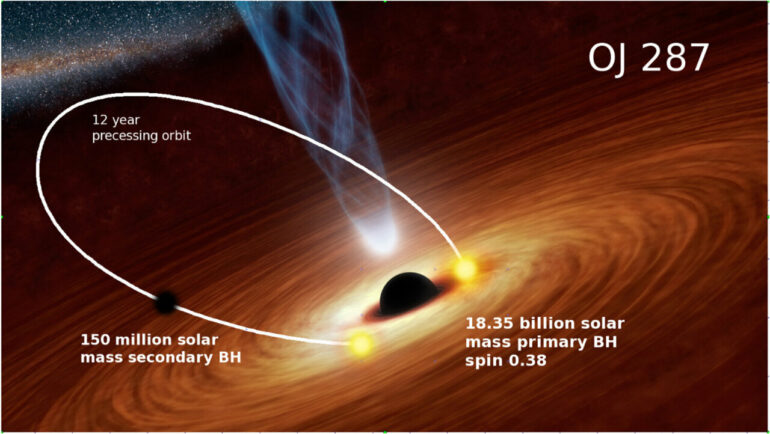The first direct detection of gravitational waves in 2015 has opened a new window on the universe, enabling in particular the observation of the merger of pairs of massive black holes. This young field of research has matured very quickly, and by now dozens of black hole mergers have been observed.
Current observations are limited to the very final stages of collapse—often for just a few seconds—when the emitted gravitational waves are extremely strong. Fortunately, several new experiments are being built that will allow researchers to observe pairs of black holes for much longer before the merger takes place, potentially even for years.
When these much more precise measurements start coming in, researchers want to be ready and able to interpret them. Pippa Cole, postdoctoral researcher in the group of Gianfranco Bertone, and first author of a new article published in Nature Astronomy, explains, “With current measurements, we can learn a few facts about the merging black holes themselves, but very little about the environment in which the merger occurs. That environment is itself extremely interesting. For example, it can teach us about one of the other current mysteries in astrophysics: that of dark matter. Once we can use an upcoming detector like LISA to observe merging black holes for much longer, it becomes possible to make meaningful statements about their environment.”
Black hole environments
There are at least three different types of interesting environments that could surround black holes. The most well-known one is a so-called accretion disk—a disk of very hot gas swirling around the black hole, like those that were recently imaged by the Event Horizon Telescope. But there are other possibilities.
A black hole could be surrounded by a cloud of ultralight particles, forming a structure that astronomers have dubbed a gravitational atom. And, finally, there could be dark matter, an elusive form of matter that appears to permeate the cosmos at all scales, but whose fundamental nature remains unknown. It is expected to accumulate around black holes as these form and grow, into high density configurations called spikes.
Cole states, “The beautiful thing is that with the new observations, it will become possible to distinguish between all three situations—as well as to distinguish them from the case where the black hole’s back yard is simply empty, where the two black holes spiral around one another in a vacuum. We managed to develop statistical techniques, that, given enough data and a large enough mass difference between the two black holes, should be able to very clearly differentiate between all four scenarios.”
According to Cole and collaborators, the upcoming generation of experiments will be able to identify gravitational waves generated by black hole mergers in the presence of an environment, be it an accretion disk, a gravitational atom, or a dark matter spike. This opens up the possibility of searching for new ultralight particles, as well as for dark matter candidates, with gravitational waves.
Bertone says, “These are exciting times. We will soon enter a new era in physics and astronomy. Just like precision particle physics allows us to search for new physics in particles accelerators on Earth, precision gravitational wave astronomy will soon allow us to search for dark matter and new particles in the universe.”
More information:
Philippa S. Cole et al, Distinguishing environmental effects on binary black hole gravitational waveforms, Nature Astronomy (2023). DOI: 10.1038/s41550-023-01990-2
Provided by
University of Amsterdam
Citation:
Disks, spikes and clouds: A peek into a black hole’s back yard (2023, June 6)
